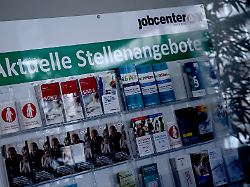Labor market in a state of emergency
Germans work more, but achieve less
By Max Bourne
April 30, 2024, 4:26 p.m
Listen to article
This audio version was artificially generated. More info | Send feedback
The economy is weakening and unemployment is rising. Nevertheless, more employees in Germany are working, overall, for more hours than ever before. At the same time, companies continue to complain about a shortage of skilled workers. This situation cannot last long.
The German labor market is in a historic state of emergency. Hourly productivity has fallen for only the second time since reunification. The value describes how much is generated in an economy per hour worked. Historically, this value continues to increase thanks, among other things, to technological developments. There are exceptions in severe economic crises. Like in 2009, when economic output as measured by gross domestic product (GDP) fell sharply, but companies did not reduce work to the same extent. 2023 was even more unusual: GDP fell by 0.3 percent, but both the number of employees and the total number of hours worked in Germany rose to a record level. This means that in Germany people work more but produce less.
Holger Schäfer, economist and labor market expert from the German Economic Institute (IW), expects this trend to continue this year, even if the economy grows slightly again. “The volume of work is expected to grow slightly faster than GDP in 2024.” This means that hourly productivity continues to fall. “However, this state of emergency is not sustainable for a long time,” says Schäfer in an interview with ntv.de. “That will change again by 2025 at the latest.” Then companies would either have to produce and sell more again – which means that GDP will grow significantly again. Or they would have to reduce work, i.e. shorten working hours, reduce overtime or cut jobs.
Declining hourly productivity is just one of several contradictory phenomena currently observed in the labor market. Employees are simultaneously complaining about the sluggish economy and a shortage of skilled workers. The volume of work, i.e. the number of all hours worked, rose to a record level in 2023 and is expected to continue to grow this year, while the average working hours per employee is falling. At the same time, unemployment is also increasing.
No solution for the coming crisis
These phenomena can partly be explained by the increasing number of employed people, i.e. the people who are available to the labor market. Most recently, these were refugees from Ukraine after the Russian invasion in 2022, many of whom entered the German labor market last year. The population and the number of working people continue to grow. Given the high demand, many of them quickly find work, but some of them remain unemployed – at least for the time being. The fact that more work is done overall when average working hours fall can also be explained by the fact that there are more people on the labor market. According to a study by the German Institute for Economic Research (DIW), in addition to immigration, the increasing number of working women is also contributing to this. However, almost half of these work part-time. This is why, on average, the working hours per employee decrease.
It is not so clear why companies in many industries are hiring more people and letting more people work despite the poor economic situation – with rising wages and salaries. It is possible that companies assume that the currently weak economy will soon improve and therefore hardly cut any jobs, even in crisis-hit sectors, says IW expert Schäfer. Another possibility is that they are “hoarding labor” to prepare for the coming demographic crisis in the labor market when the baby boomers of the mid-1960s retire.
This crisis is likely to reach its peak from 2030 onwards. Then hundreds of thousands more people will retire every year than new generations will enter the labor market. How this gap could be closed is “not yet nearly clear,” said Schäfer. The economist from the employer-related IW is critical in this context, particularly calls for a four-day week. What is needed instead is a debate about how more work can be made more attractive, for example by improving the balance between family and work.
